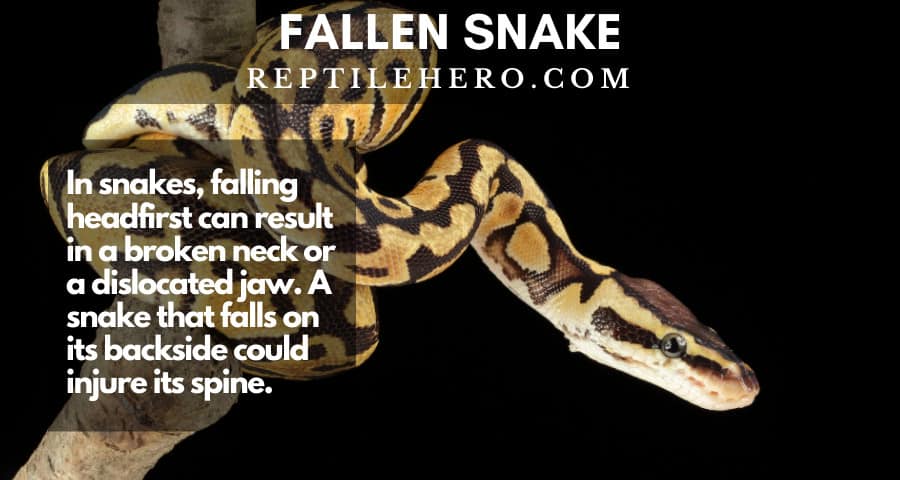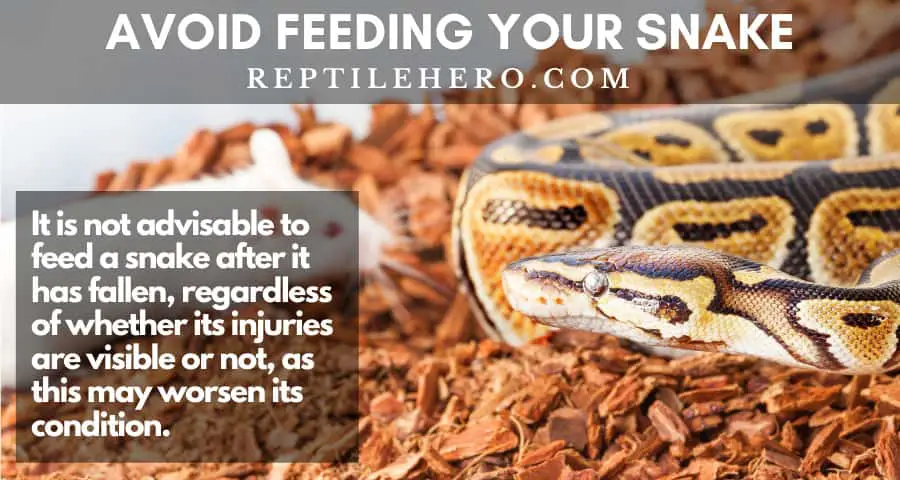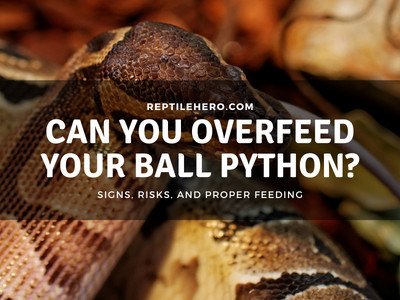Can Your Ball Python Survive a Fall?
Our snakes love exploring inside and outside their enclosure, and sometimes, accidents like falling can happen. However, as pet parents, it’s hard to take accidents like falls lightly! We can’t help but worry about what will happen to the poor snakes we love dearly after a bad fall.
Generally, ball pythons may survive a fall from 4 feet and remain uninjured. If a snake pet accidentally falls, the keeper must use a pillowcase as a stretcher to pick the snake up; observe the snake’s movements; avoid handling the snake and let it rest; avoid feeding; and bring the snake to the vet.
What should you do in case your snake falls? Will it sustain any injury from falling? Will your snake withstand the fall? Relax and take a deep breath. I have the answers to all your concerns so just continue reading!
Can Your Ball Pythons Survive a Fall?
The average ball python will survive after falling from heights of 4 feet and lower. However, the ball python’s position while falling and landing can determine possible injuries. Ball pythons may suffer from dislocated jaw or broken neck after falling headfirst, while spinal injury may be sustained from falling on the backside.
What Will Happen If You Drop a Baby Ball Python?
A baby ball python may survive a fall, and there is a good chance that the consequences of falling will be minor. After falling from a height of up to 4 feet, a hatchling ball python may survive completely unharmed.
There are numerous cases in which baby ball pythons fell onto the hard surfaces and remained uninjured.
I even once encountered an incident where a vet’s assistant dropped a hatchling ball python onto the concrete floor from about 4 feet high. The baby ball python appeared to be unscathed from the incident. Plus, the owner claims that the ball python is living and healthy to this day.
Although a hatchling ball python may survive such a fall, this does not rule out the possibility of injury. However, there’s a good chance that the consequences of falling will be minor.
You can never tell for sure. All you can do is hope for the best and keep an eye on the animal during and after the fall.
Can Ball Pythons Get Hurt From Falling?
Ball pythons are known to be resilient and normally survive after falling. However, falling headfirst may cause a broken neck or dislocated jaw in snakes. A snake falling on its backside may also experience spinal injury. Moreover, a ball python feels stunned and may not move immediately after falling.

I once witnessed my friend’s ball python fall from 3-feet. It fell onto the ground and just crawled back up to his leg. But we cannot expect all snakes to react the same way.
At first, your snake might be stunned or shocked. It may not move for several seconds, as if still processing what just happened. Then, your snake might go back to its normal activity as if nothing happened. Others may also behave strangely after falling.
Ball pythons can be tough creatures, so your snake might be okay after falling. However, it’s always best to err to the side of caution and check if your snake is indeed alright or not.
If your snake falls on a flat surface with its belly facing down, it may not sustain any injuries at all. But if your snake falls from 3 feet head first, it might suffer from injuries like jaw misalignment or even a broken neck. Your snake may also suffer from spinal injury if it falls on its backside.
So what will you do in such a case? Continue reading as I discuss how to deal with such a situation.
What Should You Do If Your Snake Falls?
Seeing your precious snake fall is stressful, to say the least. But you need to stay calm and collected to avoid possibly causing your little reptile companion distress as well.
Below are the steps you should take after your snake falls:
- Pick up the snake with a pillowcase
- Observes the snake’s behavior
- Let the snake rest without handling it
- Do not force the snake to eat
- Bring the snake to the vet
Use a Pillowcase to Pick Up Your Snake
Picking up a snake with one’s bare hands after falling can aggravate its injuries. Using a pillowcase as a snake stretcher could help prevent further injuries. If contact with the animal is unavoidable, use as little pressure as possible when touching the reptile.
I’ve read many cases of fallen snakes and their owners picking them right after falling. We apply pressure to our snake’s body when we pick them up with our hands.
If they sustained injuries from falling, this pressure could make the snake’s ribs puncture their vital organs, leading to a much worse scenario such as internal bleeding. Further injuries may be prevented by using a clean pillowcase as a stretcher for your reptile.
To pick up your snake, slowly slide the fabric under the snake’s body and continue until your pet is entirely inside the pillowcase. Remember to apply as minimal pressure as possible.
Avoid unnecessary movements such as shaking the pillowcase as it may worsen your snake’s stress and/or injuries.
Observe Your Snake’s Movement
If the snake moves oddly, it probably got injured after falling. Bulging scales on a snake may mean that it has broken ribs. Broken ribs can also be indicated by bruising and swelling. Taking the snake to the veterinarian for a thorough examination is a must in such instances.
A strong indication that your snake sustained bad injuries from falling is if it starts moving oddly after the fall. So keep your eyes peeled for strange behaviors once you have successfully picked up your slithering pet.
Place your snake on a soft surface, such as a bed, and watch how it moves and reacts. Allow your snake to crawl on top of your palm and gently feel around its body.
When a snake bends in a certain way and you see bulging areas on its body, it mostly has some broken ribs. Bruising and swelling are clear signs of broken bones too.
Begin pressing around your snake’s neck area with only the slightest pressure. Inspect your snake’s whole body, including its belly and back.
Is there any part of its body where your snake flinches? Place an object on either side of your snake as it crawls, and let the reptile touch it and continue on its path. If your pet jerks away from the object, this could be the injured area, which is sensitive.
If you see anything strange, it is best to go to the vet for a thorough examination.
Let Your Snake Rest and Avoid Handling It
Unnecessary handling of the snake may aggravate its injuries from falling. If handling is inevitable, the keeper may scoop the injured snake up using a sturdy flat object like thin plywood when cleaning its enclosure. The injured reptile must have a resting period of at least one week.
Let your snake rest for a week and monitor it closely—regardless if it needs a vet visit or not. During this time, avoid handling your snake if it’s not necessary to do so. Otherwise, your snake’s injury could worsen.
If handling is inevitable (e.g., enclosure clean-up), you can scoop your snake up by using a sturdy and flat object like thin plywood that can support the reptile’s weight without breaking.
Use your other hand to support (minimal pressure) your snake while lifting it outside the enclosure. Then, place your snake pet inside a pillowcase and secure the opening.
Afterward, put your enclosed snake inside a box—keeping them in a dark space will make them feel more secure. Moreover, The container will confine your snake and may prevent it from further injuring itself.
Finally, set the box on the floor to eliminate the snake’s chance of falling once again.
Avoid Feeding Your Snake
After falling, it is not recommended to offer food to a snake even if it does not have any visible injuries, as it may worsen the reptile’s existing condition. Visiting a vet must be done before providing food for an injured snake.

Even if there are no obvious signs of injury from falling, feeding your snake is not recommended as it might have internal injuries. Hence, its metabolism must be out of whack and it may not be able to handle and digest any food.
Of course, if your snake has visible injuries from the fall, you should also stop offering it any food in the meantime. The existing injuries in your snake from falling may worsen because of eating. Consultation with a vet is a must before offering any food to your injured snake pet.
More often than not, you will need to give your snake at least a week of complete rest before offering it any food. It is a good indication if your snake eats after the 1-week resting period.
However, if you see discoloration—bright red blood or black (digested blood)—around your snake’s vent or in its stool after he defecates, this could be a symptom of internal bleeding. Get in contact with your veterinarian as soon as possible.
Bring Your Snake to the Vet
An injured snake can be transported to a veterinary clinic by placing it in a pillowcase inside an ice chest, styrofoam box, or insulated lunch box. Periodically opening the pillowcase can allow the injured reptile to get some fresh air.
If you suspect that your snake is injured from falling, it is best to consult a vet right away. A vet may examine your snake through an x-ray to see if there are internal injuries such as broken bones, bleeding, etc. If you’re looking for one, this vet directory might be helpful.
While seeing a veterinarian can be costly, we must accept that reptiles should have the same care as our other pets when we decide to keep one.
You can transport your injured snake to the veterinarian by following these steps:
- Gently secure the injured snake in a clean pillowcase.
- Add some crumpled paper towels inside the pillowcase for cushion.
- Close and secure the cloth bag’s opening.
- Place the wrapped up snake into a small ice chest, styrofoam box, or insulated lunch box to keep it cool and safe.
- If the vet’s office is far away, periodically open the pillowcase to allow your snake to get some fresh air.
>>Learn more about traveling with reptiles in our article on transporting geckos via cars.
Can All Snakes Survive a Fall?
Smaller snakes have higher chances of surviving a fall than larger snakes. Smaller species like the flying snake can glide through the air and may survive falls from great heights. In contrast, thick-bodied snakes are less likely to survive a fall due to their weight and incapabilities.
A flying snake may survive a hundred-meter fall due to its nature. A flying snake can glide as far as 100 meters (300 feet) from the tree top by flattening its body. It propels itself by moving in a wave-like motion to increase gliding distance and maintain balance while descending [2].
However, thick-bodied snakes like the anaconda, boas, etc., may not survive falling from great heights. Aside from weighing more than the flying snake, other snakes can’t glide through the air and may drop dead on the surface.
When Do Snakes Usually Fall? (5 Cases)
Snakes might fall in the following scenarios: 1) exploring inside the enclosure, 2) escaping, 3) handling sessions, 4) cleaning sessions, and 5) climbing trees.
Enclosure Exploration
A snake may fall when it tries to explore and climb up on the ornaments inside its enclosure. Depending on the type of snake a person has, moving to a lower level and limiting the use of ornaments can reduce the risk of injury to the animal.
I asked my friends in the reptile-keeping community about times when their snakes usually fell. The majority answered that their snakes always fall when climbing on top of the ornaments inside the enclosure.
Some of us use ladders, branches, or hammocks for our snakes to climb up, but our pets might injure themselves because of these ornaments if they are not properly secured.
Depending on what snake species you have, you may want to minimize the use of these ornaments, adjust the placement to a lower level to reduce the chance of your pet getting injured, or keep them in place using animal-safe silicone.
Trying to Escape
Ball pythons and other snakes in captivity will try to escape their enclosure and may inevitably fall off onto hard surfaces. Falling injuries from escaping can be prevented if the snake is kept in an escape-proof enclosure.
I experienced such a case when I was starting the ball python hobby. My first ball python, Tesla, escaped and was trying to go down the floor. He was holding onto a cylindrical post using only his tail!
I rushed toward my snake as I wanted to catch and prevent him from falling onto the hardwood floor. Luckily, I stepped right on time and Tesla fell into my left leg.
After the incident, I changed his enclosure. I bought a tank with a locking feature and transformed it into an appropriate snake enclosure for my pet.
You can buy an enclosure like this from Zen Habitats for your ball python. If your snake is kept in an escape-proof enclosure, injuries caused by falling can be avoided.
Handling Sessions
Snakes may fall to the ground during handling sessions. Handling a snake closer to the floor can help reduce the impact and damage that a snake may sustain if it falls out of its owner’s hands.

Many keepers have experienced their snakes “jump” from their hands. I remember numerous cases when keepers tried to handle their new ball pythons. Their snakes thrust themselves toward the air and fell to the floor.
If you have only got your ball python for a few days, don’t try to handle it right away. Or else, be prepared to have it jump away from your touch too!
It will take a snake some time to adjust to its new surroundings and you, its new owner. You may want to give your snake a week or two to adapt to its new surroundings.
Then in another case, the corn snake of an experienced owner had jumped numerous times. He claimed his snake once fell from a height of about 5 feet.
You see, being an experienced keeper doesn’t rule out the possibility that your snake will try getting away from your hands.
So during handling sessions, hold your snake closer to the floor. More specifically, sitting on the floor with your snake can minimize the impact and damage that your pet may acquire if the animal accidentally falls from your hands.
Enclosure Cleaning Sessions
Ball pythons may fall when placed in a temporary container when their enclosure is being cleaned. Placing the snake into a temporary housing in a secured location can minimize the risk of it falling and getting injured.
We tend to put our snakes in temporary housing until we finish cleaning their enclosure. While we are busy cleaning, accidents like falling can happen to our snakes.
It happened when an owner put his ball python in a pillowcase and placed it on the bed. His snake crawled out of bed (2 feet in height) and fell onto the floor while still inside the pillowcase.
To prevent this from happening to your lovely snake, put your ball python in a clean and breathable pillowcase and then secure it inside a box to prevent falling while you clean its enclosure.
By doing so, your snake can still move around in a limited area without the risk of falling and becoming injured.
Climbing Trees
Snakes may climb trees to pursue prey, to defend against predators, or it is their habitat. Snakes from the wild might fall from climbing trees but may not sustain any visible injuries.
I witnessed different types of snakes falling from trees in many documentaries as I grew up. Some were hunting prey, running away from a predator, and others made the trees their home.
Many of the snakes that I watched simply slither away after falling from high trees as if nothing had happened.
Once, when my friends and I were playing at the park, we saw a roughly 6-foot-long snake fall from a tall coconut tree onto the concrete sidewalk. After making a loud thud, the snake just crawled up the same tree. It seemed like the snake didn’t get hurt from that fall at all.
How Many Bones Does a Snake Have?
Depending on the species, a snake’s body may consist of up to 600 bones. All of the snake’s internal organs are encased by its ribs. Then, a thick muscle layer surrounds the ribs, and the outside is covered in scales.
Have you ever wondered if a snake has any bones in its body? What do the internal organs of a snake look like? You probably have many questions like these as well, since snakes are really interesting animals!
Because snakes are so flexible, it’s easy to believe they have no bones. However, snakes, in reality, do have bones. They have hundreds more than we do! Snakes could have up to 600 individual bones [1].
Here are snake species commonly kept as pets:
- Corn snakes
- Kingsnakes
- Ball pythons
- Boas
- Reticulated pythons
Aside from having differences in temperament, their size greatly differs too. More importantly, a snake’s size is related to how active it usually is. While visiting a friend, I noticed that his corn snake moves a lot compared to my ball python. It turns out that slender snake species tend to be more active than thick-bodied ones!
Further Questions
Do snakes bleed when they fall?
Yes, snakes can bleed after falling. Snakes may bleed if they fall on sharp objects. Larger species of snakes may bleed and create a massive splat if they fall from great heights. Internal bleeding might occur in snakes if their ribs puncture vital organs due to falling.
What if I accidentally dropped something on my snake?
Accidentally dropping light objects on a snake may cause them to display defensive behavior due to fright. Heavy objects may cause injury such as bruising, broken bones, etc. if accidentally dropped on a snake. Furthermore, dropping sharp objects on a snake may result in bleeding due to cuts, decapitation, or death.
Summary of Snakes Surviving From a Fall
Ball pythons, especially hatchlings, can survive after falling from heights of 4 feet and less. More specifically, a snake’s position upon landing on the ground determines whether or not it will get injured. A snake that falls on its belly is not likely to sustain any physical damage.
If a snake pet falls, the keeper must 1) use a pillowcase to secure the snake up, 2) observe the snake’s behavior, 3) refrain from handling the resting snake, 4) temporarily stop feeding, and 5) bring it to an experienced exotic vet.
A snake can fall while exploring its enclosure, trying to escape, being handled, staying in a temporary container, or climbing trees.
Sources
[1]
https://www.britannica.com/animal/snake/Form-and-function
[2]






